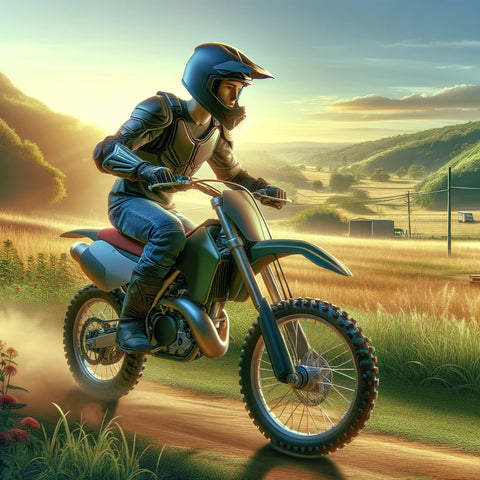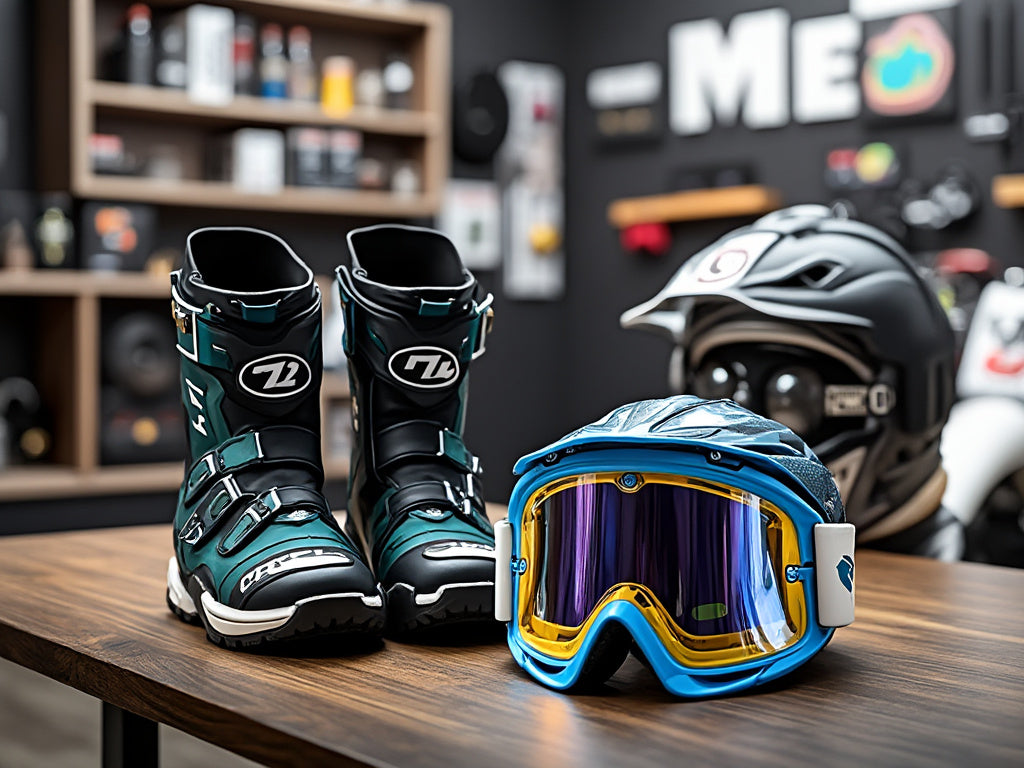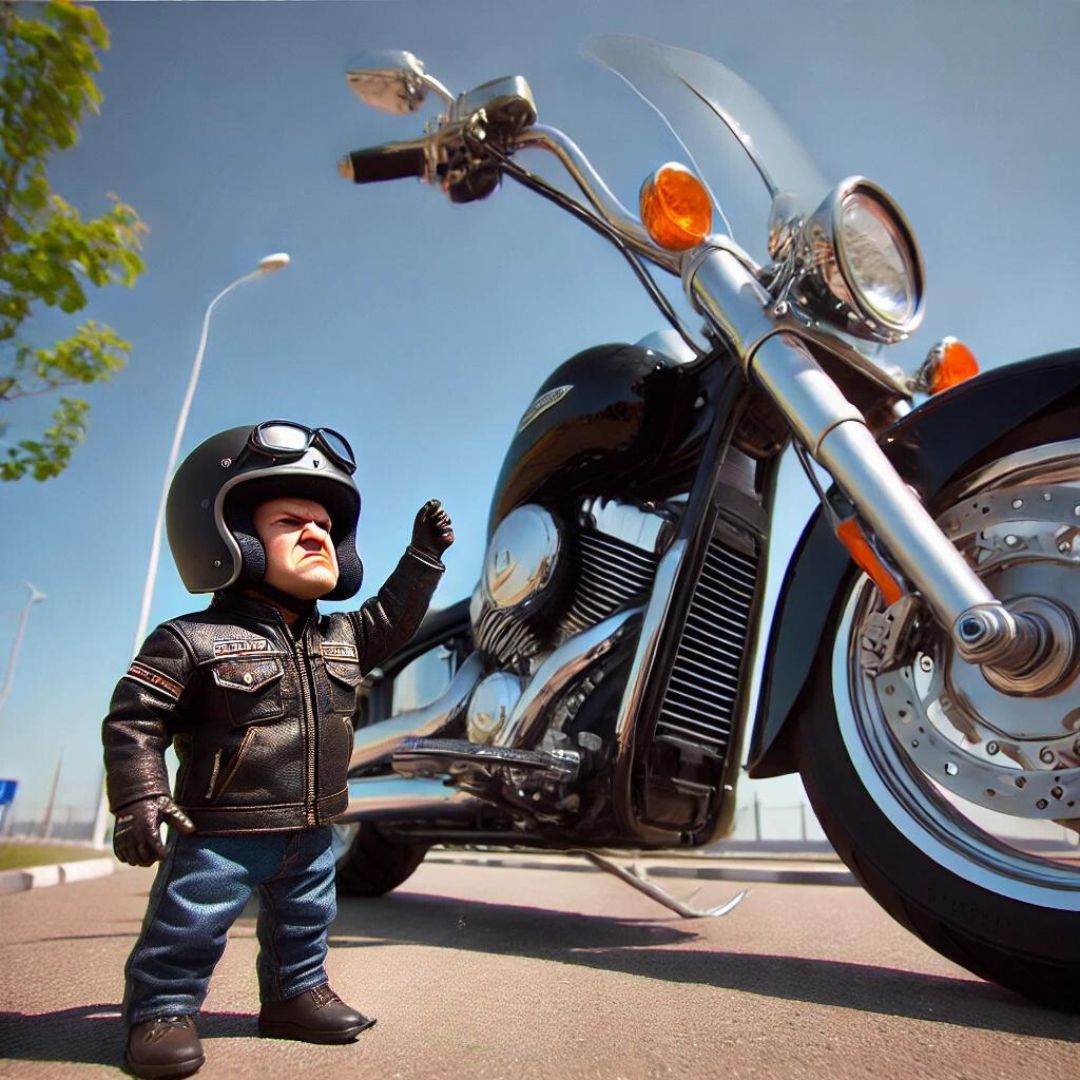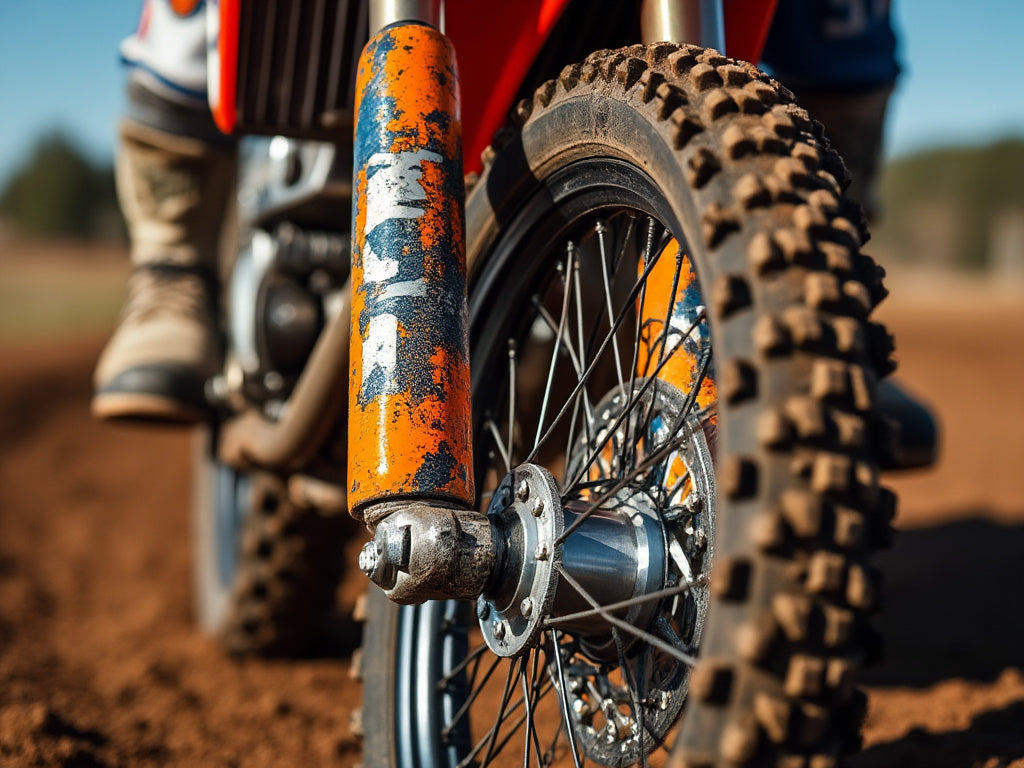
Published: 19.2.24
Updated: 28.6.24
Ever wondered why some dirt bike riders make navigating challenging terrains look like a walk in the park?
Well, it all boils down to mastering the art of body positioning.
Whether you’re guiding your kids into the world of dirt biking or looking to refine your own skills, understanding the basics of body positioning is crucial.
It’s not just about looking good on the bike; it’s about ensuring safety, maintaining control, and boosting performance.
Let’s dive into the essential tips that every rider should know.
The Essentials of Body Positioning
Before you hit the trails, let's get down to the basics.
Body positioning on a dirt bike isn't just about comfort; it's about making every ride safer, smoother, and more exhilarating.
Here's where we start shaping you into not just a rider, but a savvy navigator of any terrain.
1. The Critical Role of Proper Body Position
- Safety First: Correct body positioning is paramount for safety. It minimises the risk of falls and injuries by ensuring better control over the bike.
- Enhanced Performance: Proper posture improves balance and efficiency, enabling smoother rides and better handling of the bike in various terrains.
-
Key Elements:
- Head Up: Always keep your head up and eyes forward.
- Back Straight: Maintain a straight back to reduce fatigue and improve balance.
- Relaxed Shoulders: Keep your shoulders relaxed to avoid tension and allow for flexibility.
2. The Ideal Riding Stance: Your Foundation on the Bike
- Standing Tall: On rough terrains, standing on the footpegs with knees slightly bent absorbs impacts better than sitting down.
- Balance and Control: A proper riding stance enhances your bike's stability, making it easier to manoeuvre through challenging paths.
-
Stance Practice:
- Footpeg Balance: Spend time standing on the pegs while stationary to get comfortable with the balance point.
- Moving Practice: Ride at a slow pace in a safe area, focusing on maintaining your stance through various manoeuvres.
Core Techniques
Dive deeper with these core techniques that every dirt bike enthusiast must master.
From the precise placement of your feet to the strategic grip of your hands, these are the game-changers that separate the amateurs from the pros.
3. Mastering Foot Placement: The Foundation of Balance and Control
- Why It Matters: Keeping the balls of your feet on the pegs isn't just about form; it's about function. This position primes you for quick movements and adjustments, essential for navigating unpredictable terrains.
-
Quick Tips:
- Always reset your feet to the pegs after shifting or braking.
- Practice standing rides to get comfortable with this foot placement.
4. Hand Placement: Steering with Precision and Ease
- Grip Dynamics: A firm yet gentle grip on the handlebars allows for responsive steering and helps prevent fatigue. Think of holding a bird without letting it go or squeezing too tight.
- Elbows Up: Keeping your elbows up not only aids in better control but also prepares you to absorb impacts more effectively.
- Practice Point: Try different grip strengths on safe terrains to find your optimal handling balance.
5. Looking Ahead: Anticipating the Path Forward
- Vision Leads: Your bike goes where your eyes lead. Looking ahead helps you prepare for what’s coming, allowing for smoother navigation and reaction.
- Trail Scanning: Practice scanning far ahead while also being aware of your immediate surroundings. This dual focus helps in anticipating and reacting to obstacles efficiently.
Advanced Maneuvers
"Think you've got the basics down?
It's time to push the envelope with advanced manoeuvres that will set you apart on the track.
These tips are your secret weapon for tackling the toughest turns and mastering the art of balance and agility.
Strap in; it's about to get real.
6. The Art of Body Leaning: Mastering Turns and Traction
- Lean, Not Tilt: Understand the difference between leaning your body and tilting the bike. You want to lean into the turn while keeping the bike as upright as possible for optimal tire traction.
- Practice Drill: Set up a slalom course with cones to practice leaning through turns at various speeds.
7. Absorbing Impact: Your Body as the Ultimate Suspension
- Legs and Arms as Shock Absorbers: Learn to use your legs and arms to absorb shocks from bumps, jumps, and rough terrain. This technique reduces fatigue and keeps you in control.
- Drill for Skill: Practice riding over small obstacles, focusing on using your limbs to soften the impact, gradually increasing difficulty as you improve.
8. Braking and Accelerating: Weight Shifting for Control
- Rearward for Braking: When braking, shift your weight to the rear to prevent the front wheel from locking and skidding.
- Forward for Accelerating: Lean slightly forward when accelerating to distribute your weight, enhancing traction and control.
- Exercise: Practice abrupt starts and stops in a safe area to get a feel for how your body position affects braking and acceleration.
Skill Development
Practice doesn't just make perfect; it makes permanent.
Here in the skill development zone, we're all about turning those techniques into second nature.
With targeted drills and the right mindset, you're on your way to becoming the dirt biking hero you've always wanted to be.
9. Cornering: Combining Speed, Lean, and Look
- Outside Foot Down: Pressing down on the outside footpeg can help maintain balance and traction through the turn.
- Eyes on the Exit: Always look through the turn to where you want to go, which naturally helps guide the bike.
- Cornering Practice: Use a familiar track to practice cornering, focusing on your foot, body lean, and gaze to improve your technique.
10. Practice Drills: Turning Knowledge into Skill
- Consistency is Key: Regular, focused practice on specific skills turns them into second nature.
- Varied Terrain: Practice on different terrains to adapt your skills to various conditions.
- Family Fun: Make practice a fun activity with family or friends, setting up challenges or mini-competitions to keep engagement high.
Latest Dirt Biking Techniques and Gear
Dirt bike riding is an exhilarating sport that combines skill, technique, and the right equipment.
Here are some of the latest techniques and gear recommendations for dirt bike riders:
Riding Techniques
-
Body Positioning: Maintain a forward-leaning stance with elbows up and head over the handlebars for optimal control. This position allows for better maneuverability and absorption of impacts. Proper body positioning is crucial for handling rough terrains and ensuring safety.
-
Throttle and Clutch Control: Practice smooth and precise movements to ensure seamless power delivery across various terrains. Mastering throttle and clutch control can significantly enhance your riding efficiency and performance.
-
Cornering: Lean the bike in the desired direction while shifting your body weight accordingly. Choose the right line and keep your vision ahead for better control. Effective cornering techniques can drastically improve your ability to navigate turns and curves.
-
Braking: Master the use of both front and rear brakes in conjunction with downshifting for controlled stops. Proper braking techniques are essential for maintaining control and preventing skids or falls.
-
Terrain-Specific Techniques: Adapt your riding style to different terrains, such as flat tracks, hills, and obstacles like rocks and ruts. Being versatile in your techniques allows you to handle a variety of challenges that different terrains present.
Essential Gear
-
Helmet: A high-quality, properly fitting helmet that meets safety standards and provides adequate ventilation. Helmets are the most critical piece of safety equipment, protecting your head from injuries.
-
Goggles: Look for anti-fog and UV-resistant lenses to protect your eyes from dust, debris, and sun glare. Goggles ensure clear vision and eye protection in varying conditions.
-
Jersey and Pants: Opt for lightweight, breathable, and durable materials that offer protection and freedom of movement. Proper riding attire can protect you from abrasions and enhance comfort during rides.
-
Boots: Sturdy, ankle-high boots are crucial for foot and ankle protection. Boots provide support and protection, reducing the risk of injuries from impacts or falls.
-
Body Armor: Consider additional protective gear such as chest protectors, knee braces, and elbow guards for enhanced safety. Body armor can protect vital areas from injuries during crashes or collisions.
| Gear Item | Description | Recommendation |
|---|---|---|
| Helmet | A high-quality, properly fitting helmet that meets safety standards and provides adequate ventilation. | Look for DOT or Snell certified helmets with adjustable ventilation. |
| Goggles | Anti-fog and UV-resistant lenses to protect your eyes from dust, debris, and sun glare. | Choose goggles with interchangeable lenses for varying light conditions. |
| Jersey and Pants | Lightweight, breathable, and durable materials that offer protection and freedom of movement. | Opt for moisture-wicking fabrics to keep you dry and comfortable. |
| Boots | Sturdy, ankle-high boots for foot and ankle protection. | Look for boots with reinforced soles and ankle support. |
| Body Armor | Additional protective gear such as chest protectors, knee braces, and elbow guards. | Invest in body armor that fits well and provides adequate coverage without restricting movement. |
Tips to Improve Your Skills
-
Regular Practice: Practice regularly in open areas to build confidence and master basic techniques. Consistent practice is key to developing and refining your skills.
-
Focus on Body Positioning and Balance: Proper body positioning and balance are essential to maintain control and stability. Always be mindful of your posture and weight distribution while riding.
-
Gradually Increase Difficulty Levels: As you become more comfortable with your bike and riding techniques, gradually increase the difficulty levels. This progression helps in building your skills and confidence incrementally.
-
Seek Guidance and Training: Consider taking a dirt bike riding course or seeking guidance from experienced riders to accelerate your learning curve. Professional instruction can provide valuable insights and techniques.
Remember to always prioritise safety by wearing appropriate gear, inspecting your bike before rides, and riding within your skill level.
With consistent practice and the right equipment, you can enhance your dirt biking experience and tackle more challenging terrains.
<<<<<< Please feel free to download the free quiz on the correct Dirt Bike Body Position >>>>>>
Bonus Tips: Elevating Your Dirt Biking Skills Beyond the Basics
Thought you knew it all?
We've got some bonus tips that will blow your mind and elevate your dirt biking skills beyond the basics.
From staying hydrated to joining a community, these extra nuggets of wisdom are the cherry on top of your dirt biking adventure.
Stay Hydrated and Energised
- Why It Matters: Endurance is key in dirt biking. Staying hydrated and maintaining energy levels can make a significant difference in your focus, control, and overall riding experience.
- Quick Tip: Always carry a hydration pack and energy-rich snacks on longer rides.
Maintenance Matters: Keep Your Bike in Top Shape
- Bike Care: Regular maintenance of your dirt bike not only ensures safety but also improves performance. A well-tuned bike responds better to your body movements and commands.
- Routine Checks: Develop a pre- and post-ride checklist including tire pressure, brake function, and chain lubrication.
Mind Over Matter: The Mental Aspect of Riding
- Focus and Determination: Dirt biking is as much a mental challenge as it is physical. Cultivating a focused and positive mindset can help you overcome obstacles and improve with each ride.
- Visualisation Techniques: Practice visualising successful rides and tricky maneuvers to build confidence and reduce anxiety.
Join a Community: Learn and Grow Together
- Shared Learning: Joining a dirt biking community or club can accelerate your learning curve. Tips, experiences, and advice from fellow riders can provide invaluable insights.
- Group Rides: Participating in group rides not only enhances your social experience but also allows you to observe and learn different riding styles and techniques firsthand.
Visualisation Techniques and Mental Focus
Visualisation techniques and mental focus can significantly enhance a dirt bike rider's ability to master proper body positioning.
Here are some key approaches:
-
Mental Rehearsal: Practice visualising successful rides and tricky maneuvers to build confidence and reduce anxiety before actually performing them. This mental preparation helps create neural pathways that can improve physical execution. Imagine yourself navigating through difficult terrains smoothly and confidently.
-
Body Awareness Visualisation: Imagine how you want your skeletal system to move during different riding techniques. Visualise the correct positioning of your arms, legs, and core while mentally going through motions like cornering or jumping. This method helps in ingraining the proper form into muscle memory.
-
Relaxation Visualisation: Picture a warm current flowing down your body, relaxing tense muscles. Add a colour to this mental image, like orange for warmth or blue for cooling, to enhance the relaxation effect. This technique can help in maintaining a relaxed yet alert state while riding.
-
Terrain Anticipation: Use visualisation to mentally prepare for different terrains and obstacles. Imagine yourself successfully navigating through rocks, ruts, or steep inclines while maintaining proper body position. This prepares your mind to react appropriately when encountering similar situations in reality.
-
Focus on the "Attack Position": Visualise yourself in the optimal attack position - hips towards the rear of the bike, knees bent, and the balls of your feet on the footpegs. Mental rehearsal of this position can help ingrain it as muscle memory, making it easier to assume this stance instinctively during rides.
-
Biofeedback Integration: While visualising, pay attention to how your body feels. Notice any areas of tension or imbalance, and mentally adjust your position to correct these issues. This helps in becoming more attuned to your body's signals and making necessary adjustments during actual riding.
-
Pre-Ride Mental Preparation: Before hitting the trails, take a few moments to visualise yourself riding with perfect form. This can help set a positive mindset and reinforce proper techniques. Visualising a successful ride can boost your confidence and readiness.
-
Obstacle-Specific Visualisation: For challenging features like jumps or tight turns, mentally rehearse the correct body positioning and movements required to navigate them successfully. Visualise yourself executing these maneuvers flawlessly, which can help reduce anxiety and improve performance when facing these obstacles.
By incorporating these visualisation techniques and maintaining mental focus on proper body positioning, dirt bike riders can accelerate their learning curve and improve their overall performance on the trails.
Conclusion
And there you have it - 10 essential tips that form the foundation of proficient dirt biking.
Remember, mastering body positioning is a journey, one that promises safer rides and heightened enjoyment of this thrilling sport.
So gear up, embrace the practice, and watch as you transform challenges into triumphs on the trail.
Here’s to safe and exhilarating dirt biking adventures ahead!







Share:
The Ultimate Showdown: Comparing Indoor vs. Outdoor Go Karting Experiences
Everything You Need To Know About Drift Karts